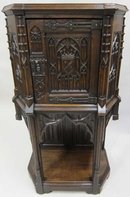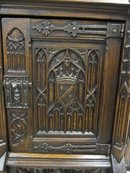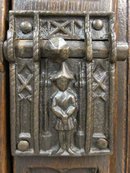Small Gothic Cabinet (Argenterie)




Unavailable
Although this small cabinet was purchased with two larger cabinets as part of a Gothic dining set, it is not part of a matching set as we might see in today's furniture stores. Indeed, only the chairs in this set match one another. The other pieces are all distinct and apparently made by different artisans but are united by the elements of Gothic style such as arches, tracery (fenestrage), finials and plis-de-serviette panels. In overall design, this cabinet is small and slim, with a case at the top and a potboard below - a classic argenterie or piece of furniture used in the dining room for locking up the silverware (argent). The sole, central door is intricately carved but using a layout we have never seen before. There is a main panel taking up most of the door but smaller panels are found above and below the lock. The more standard approach would have been to extend the main panel around the lock along with the metal straps, all the way to the left side. As with many pieces, we discover this enigma and ask ourselves what the designer was thinking? Maybe just wanting to do something different for a change! The placement of the coat-of-arms amidst the tracery filling the central ogive arch within the main rounded arch of the door panel is a triumph of Gothic design reflecting the work of a 19th century master in thrall to the medieval architectural designs of his forbears. The shape of the escutcheon dates back to a design used for shields in heraldry from the 1430s. Separating it into two fields, and running from upper right to lower left, is a bend sinister, or barre, as it is known in French heraldry. In the upper left field is a lozenge or rhombus, which may be a reference to the village of Douzens in the Aude region of southwestern France whose coat of arms has the lozenge as its central symbol. In the lower right field is a roundel, which derived from the apple or pomme. Atop the escutcheon is a crown in the form of that used by a viscount or vicomte having alternating high and low points. The balance of the central panel is filled with tall, narrow lancet arches supporting the shield and mouchettes above the crown. Above the lock is a wonderful figure that reminds us of an apse or a small chapel in a Gothic cathedral. Simple, in the shape of a slightly pointed arch, it contains lancet arches supporting a multi-lobed figure of tracery. Below the lock is an oddly shaped rectangle filled with unusual bits of tracery. The metal lock, with sliding pin, is a masterpiece of medieval design and detail, including lancet arches and a central figure posed in a niche. Once opened, the cabinet's interior includes one shelf. Framing the door panel are ribbed pillars topped by crocketed finals but the crocketing is stylized, in the form of balls echoing the roundel of the shield and the points of the crown. The sides of the top part of the cabinet are also intricately carved in tracery patterns separated by columns supporting finials. This is likely an indication that the piece was made for someone who adored these elements of Gothic design, since otherwise the less visible side panels were often plain or decorated with the less ornate plis-de-serviette panels. Such panels comprise the back vertical panel of the potboard, framed on either side by open tracery connecting the back panels to the tops of the columns supporting the front and in between those columns as well. Reference Ader-Tajan, Collection Bruno Perrier Haute Epoque (Catalog for Sale at Auction on April 6, 1992 at the Hôtel Drouot, Paris); Boccador, Jacqueline, Le Mobilier Français du Moyen Age à la Renaissance, Editions d'Art Monelle Hayot (Saint-Just-en-Chaussée, 1988); Neubecker, Ottfried, Le Grand Livre de L'Héraldique, (Elsevier Séquoia, Brussels, 1977) Thirion, Jacques, Le Mobilier du Moyen Age et de la Renaissance en France (Editions Faton, Dijon, 1998); Viollet-le-Duc, Eugène, Le Mobilier Médiéval (Georges Bernage, editor) (Editions Heimdal, 2003). Uses We have offered several argenteries over the years and have found that they are the perfect "occasional cabinet" for home or office, complementing other styles of furniture while drawing attention to incomparable artistry in a diminutive format. For more information, visit M. Markley Antiques on the Web -- the premier resource in the U.S. for French Gothic Revival and Renaissance Revival furniture, including Henri II and Louis XIII styles.
M. Markley Antiques
Spring, Texas
Dealer accepts: Check
Shipping: Negotiated with Seller



